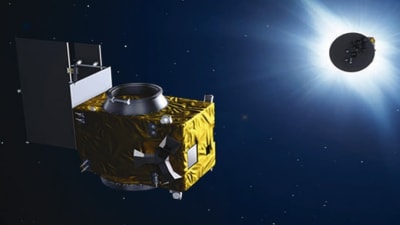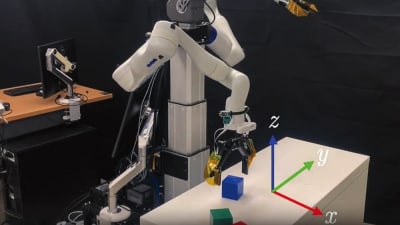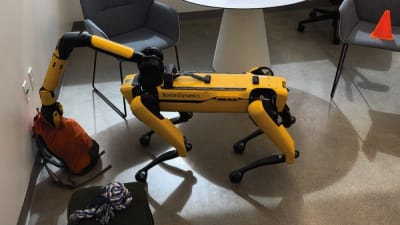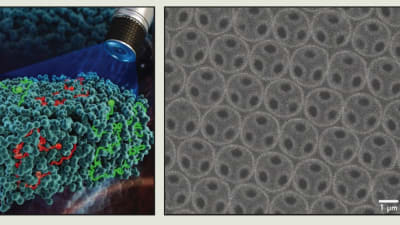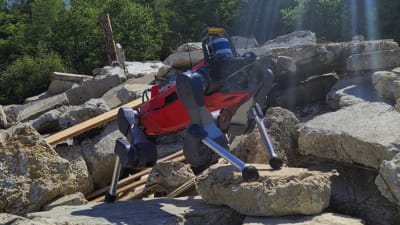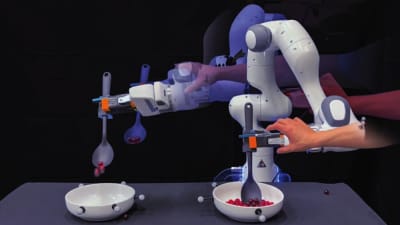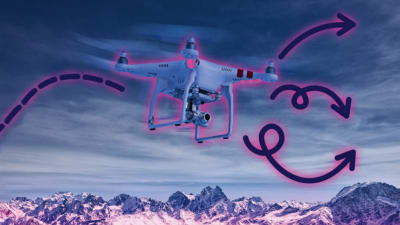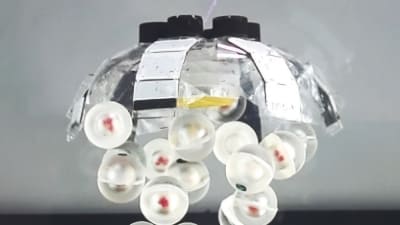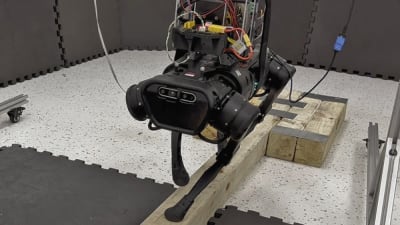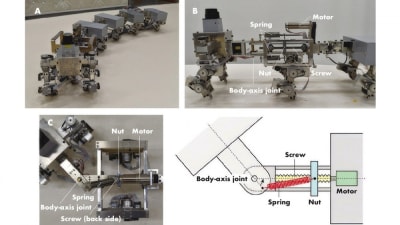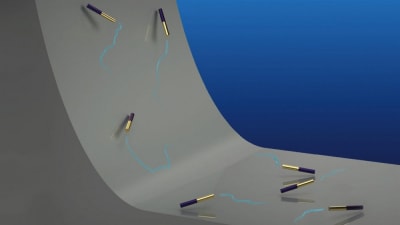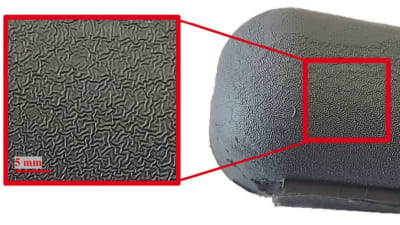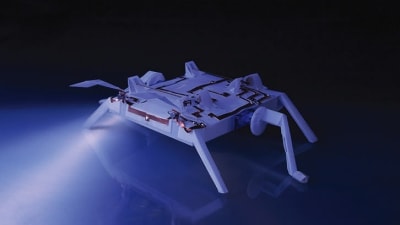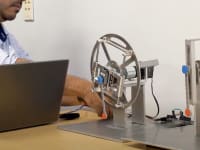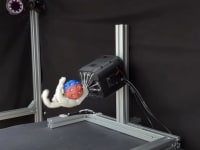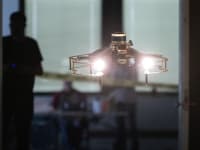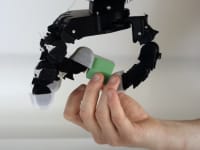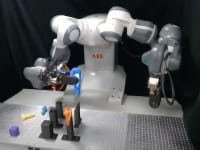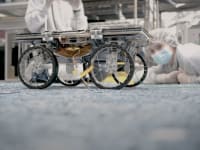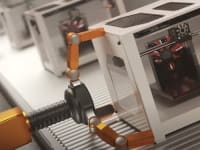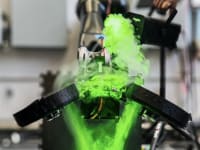40
61
169
-1
0
30
Briefs: RF & Microwave Electronics
NASA has developed an innovative combination of a Magnetometer, low-powered ElectroMagnets, and Resonant Inductive Coupling (MEMRIC) to create and control relative positioning of nano satellites within a cluster. This is a game-changing approach to enable distributed nanosatellite (nanosat) clusters. Read on to learn more.
Briefs: Motion Control
Researchers from MIT and NVIDIA Research have developed a novel algorithm that dramatically speeds up a robot’s planning process. Their approach enables a robot to “think ahead” by evaluating thousands of possible solutions in parallel and then refining the best ones to meet the constraints of the robot and its environment. Read on to learn more.
Briefs: Mechanical & Fluid Systems
Researchers have created a light-powered soft robot that can carry loads through the air along established tracks, similar to cable cars or aerial trams. The soft robot operates autonomously, can climb slopes at angles of up to 80°, and can carry loads up to 12 times its weight. Read on to learn more.
Briefs: Mechanical & Fluid Systems
It’s a game a lot of us played as children — and maybe even later in life: unspooling measuring tape to see how far it would extend before bending. But to engineers at the University of California San Diego, this game was an inspiration, suggesting that measuring tape could become a great material for a robotic gripper. Read on to learn more about their robot, GRIP-tape.
Briefs: Robotics, Automation & Control
These materials can detect when they are damaged, take the necessary steps to temporarily heal themselves, and then resume work.
Briefs: Software
A team of MIT engineers has developed a training method for multiagent systems that can guarantee their safe operation in crowded environments. Read on to learn more about it.
Briefs: Motion Control
In a recent study published in the journal eLife, an international research group has studied the relationship between electrical stimulation in stick insects’ leg muscles and the resultant torque (the twisting force that makes the leg move). Read on to learn what they found.
Briefs: Motion Control
Innovators at the NASA Johnson Space Center have developed a novel foot-pedal-operated system and device to control movement of an object in 3D space. The Foot Pedal Controller system enables operators to control movement of spacecraft, aircraft, and watercraft using only foot pedals. Read on to learn more.
Briefs: Physical Sciences
Researchers have developed a new soft robot design that engages in three simultaneous behaviors: rolling forward, spinning like a record, and following a path that orbits around a central point. The device, which operates without human or computer control, holds promise for developing soft robotic technologies that can be used to navigate and map unknown environments. The new soft robots are called twisted ringbots. Read on to learn more about them.
Briefs: Electronics & Computers
MIT engineers have developed a method that enables robots to make similarly intuitive, task-relevant decisions. The team’s new approach, named Clio, enables a robot to identify the parts of a scene that matter, given the tasks at hand. Read on to learn more about Clio.
Briefs: Photonics/Optics
The “nanoswimmers” could be used to remediate contaminated soil, improve water filtration, or even deliver drugs to targeted areas of the body.
Briefs: Robotics, Automation & Control
ANYmal has for some time had no problem coping with the stony terrain of Swiss hiking trails. Now researchers at ETH Zurich have taught this quadrupedal robot some new skills: it is proving rather adept at parkour. ANYmal is also proficient at dealing with the tricky terrain commonly found on building sites or in disaster areas. Read on to learn more.
Briefs: Electronics & Computers
MIT engineers are aiming to give robots a bit of common sense when faced with situations that push them off their trained path. They’ve developed a method that connects robot motion data with the “common sense knowledge” of large language models, or LLMs.
Briefs: Materials
A technique enables manufacturing of minuscule robots by interlocking multiple materials in a complex way.
Briefs: Unmanned Systems
Researchers from MIT and Stanford University have devised a new machine-learning approach that could be used to control a robot, such as a drone or autonomous vehicle, more effectively and efficiently in dynamic environments where conditions can change rapidly.
Briefs: Motion Control
Grasping objects is a problem that is easy for a human, but challenging for a robot. Researchers designed a soft, 3D-printed robotic hand that cannot independently move its fingers but can still carry out a range of complex movements.
Briefs: Motion Control
One of the strategies to combat the mounds of waste found in oceans — especially around coral reefs — is to employ robots to master the cleanup. However, existing underwater robots are mostly bulky with rigid bodies, unable to explore and sample in complex and unstructured environments, and are noisy due to electrical motors or hydraulic pumps.
Briefs: Motion Control
Researchers in Carnegie Mellon University’s Robotics Institute have designed a system that makes an off-the-shelf quadruped robot nimble enough to walk a narrow balance beam — a feat that is likely the first of its kind.
Briefs: Robotics, Automation & Control
Researchers have invented a new kind of walking robot that takes advantage of dynamic instability to navigate. By changing the flexibility of the couplings, the robot can be made to turn without the need for complex computational control systems.
Briefs: Mechanical & Fluid Systems
The tiny motors mimic how rock climbers navigate inclines.
Briefs: Motion Control
A catalytic reaction causes a two-dimensional, chemically coated sheet to spontaneously morph into a three-dimensional gear.
Briefs: Imaging
Inspired by the human finger, MIT researchers have developed a robotic hand that uses high-resolution touch sensing to accurately identify an object after grasping it just one time.
Briefs: AR/AI
Researchers from MIT’s Improbable Artificial Intelligence Lab have developed a legged robotic system that can dribble a soccer ball under the same conditions as humans.
Briefs: Robotics, Automation & Control
Roboticists have been using a technique similar to origami to develop autonomous machines out of thin, flexible sheets. These lightweight robots are simpler and cheaper to make and more compact for easier storage and transport.
Briefs: Medical
Achievable coils increase the capabilities of the micromotors.
Briefs: Motion Control
The skin could help rehabilitation and enhance virtual reality by instantaneously adapting to a wearer's movements.
Briefs: Robotics, Automation & Control
Ornithological animals have always benefited from folding their wings during upstroke. So, a Swedish-Swiss research team has constructed a robotic wing that can flap like a bird.
Briefs: Software
Interactive program aids motion planning for environments with obstacles.
Briefs: AR/AI
A Data-Driven Framework for Testing the Safety of Legged Robots
When it comes to the evolution of mobile robots, it may be a long time before legged robots are able to safely interact in the real world, according to a new study.
Top Stories
Blog: Manufacturing & Prototyping
2025 Holiday Gift Guide for Engineers: Tech, Tools, and Gadgets
INSIDER: Electronics & Computers
Scientists Create Superconducting Semiconductor Material
Blog: Software
Blog: Materials
This Paint Can Cool Buildings Without Energy Input
Quiz: Automotive
Blog: Semiconductors & ICs
Webcasts
 Upcoming Webinars: Manufacturing & Prototyping
Upcoming Webinars: Manufacturing & Prototyping
The Real Impact of AR and AI in the Industrial Equipment Industry
 Upcoming Webinars: Motion Control
Upcoming Webinars: Motion Control
Next-Generation Linear and Rotary Stages: When Ultra Precision...
 Podcasts: Energy
Podcasts: Energy
SAE Automotive Podcast: Solid-State Batteries
 Podcasts: Medical
Podcasts: Medical
How Wearables Are Enhancing Smart Drug Delivery
 Podcasts: Manufacturing & Prototyping
Podcasts: Manufacturing & Prototyping
SAE Automotive Engineering Podcast: Additive Manufacturing
 Podcasts: Aerospace
Podcasts: Aerospace
A New Approach to Manufacturing Machine Connectivity for the Air Force


